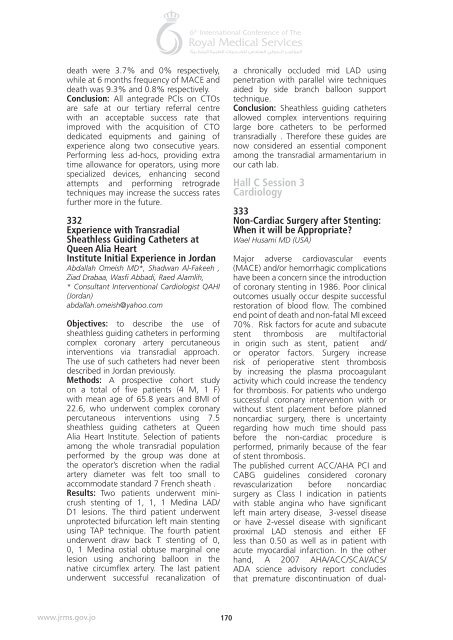Abstract book 6th RMS 16.indd
Abstract book 6th RMS 16.indd
Abstract book 6th RMS 16.indd
Create successful ePaper yourself
Turn your PDF publications into a flip-book with our unique Google optimized e-Paper software.
death were 3.7% and 0% respectively,<br />
while at 6 months frequency of MACE and<br />
death was 9.3% and 0.8% respectively.<br />
Conclusion: All antegrade PCIs on CTOs<br />
are safe at our tertiary referral centre<br />
with an acceptable success rate that<br />
improved with the acquisition of CTO<br />
dedicated equipments and gaining of<br />
experience along two consecutive years.<br />
Performing less ad-hocs, providing extra<br />
time allowance for operators, using more<br />
specialized devices, enhancing second<br />
attempts and performing retrograde<br />
techniques may increase the success rates<br />
further more in the future.<br />
332<br />
Experience with Transradial<br />
Sheathless Guiding Catheters at<br />
Queen Alia Heart<br />
Institute Initial Experience in Jordan<br />
Abdallah Omeish MD*, Shadwan Al-Fakeeh ,<br />
Ziad Drabaa, Wasfi Abbadi, Raed Alamlih,<br />
* Consultant Interventional Cardiologist QAHI<br />
(Jordan)<br />
abdallah.omeish@yahoo.com<br />
Objectives: to describe the use of<br />
sheathless guiding catheters in performing<br />
complex coronary artery percutaneous<br />
interventions via transradial approach.<br />
The use of such catheters had never been<br />
described in Jordan previously.<br />
Methods: A prospective cohort study<br />
on a total of five patients (4 M, 1 F)<br />
with mean age of 65.8 years and BMI of<br />
22.6, who underwent complex coronary<br />
percutaneous interventions using 7.5<br />
sheathless guiding catheters at Queen<br />
Alia Heart Institute. Selection of patients<br />
among the whole transradial population<br />
performed by the group was done at<br />
the operator’s discretion when the radial<br />
artery diameter was felt too small to<br />
accommodate standard 7 French sheath .<br />
Results: Two patients underwent minicrush<br />
stenting of 1, 1, 1 Medina LAD/<br />
D1 lesions. The third patient underwent<br />
unprotected bifurcation left main stenting<br />
using TAP technique. The fourth patient<br />
underwent draw back T stenting of 0,<br />
0, 1 Medina ostial obtuse marginal one<br />
lesion using anchoring balloon in the<br />
native circumflex artery. The last patient<br />
underwent successful recanalization of<br />
a chronically occluded mid LAD using<br />
penetration with parallel wire techniques<br />
aided by side branch balloon support<br />
technique.<br />
Conclusion: Sheathless guiding catheters<br />
allowed complex interventions requiring<br />
large bore catheters to be performed<br />
transradially . Therefore these guides are<br />
now considered an essential component<br />
among the transradial armamentarium in<br />
our cath lab.<br />
Hall C Session 3<br />
Cardiology<br />
333<br />
Non-Cardiac Surgery after Stenting:<br />
When it will be Appropriate?<br />
Wael Husami MD (USA)<br />
Major adverse cardiovascular events<br />
(MACE) and/or hemorrhagic complications<br />
have been a concern since the introduction<br />
of coronary stenting in 1986. Poor clinical<br />
outcomes usually occur despite successful<br />
restoration of blood flow. The combined<br />
end point of death and non-fatal MI exceed<br />
70%. Risk factors for acute and subacute<br />
stent thrombosis are multifactorial<br />
in origin such as stent, patient and/<br />
or operator factors. Surgery increase<br />
risk of perioperative stent thrombosis<br />
by increasing the plasma procoagulant<br />
activity which could increase the tendency<br />
for thrombosis. For patients who undergo<br />
successful coronary intervention with or<br />
without stent placement before planned<br />
noncardiac surgery, there is uncertainty<br />
regarding how much time should pass<br />
before the non-cardiac procedure is<br />
performed, primarily because of the fear<br />
of stent thrombosis.<br />
The published current ACC/AHA PCI and<br />
CABG guidelines considered coronary<br />
revascularization before noncardiac<br />
surgery as Class I indication in patients<br />
with stable angina who have significant<br />
left main artery disease, 3-vessel disease<br />
or have 2-vessel disease with significant<br />
proximal LAD stenosis and either EF<br />
less than 0.50 as well as in patient with<br />
acute myocardial infarction. In the other<br />
hand, A 2007 AHA/ACC/SCAI/ACS/<br />
ADA science advisory report concludes<br />
that premature discontinuation of dual-<br />
www.jrms.gov.jo<br />
170

















